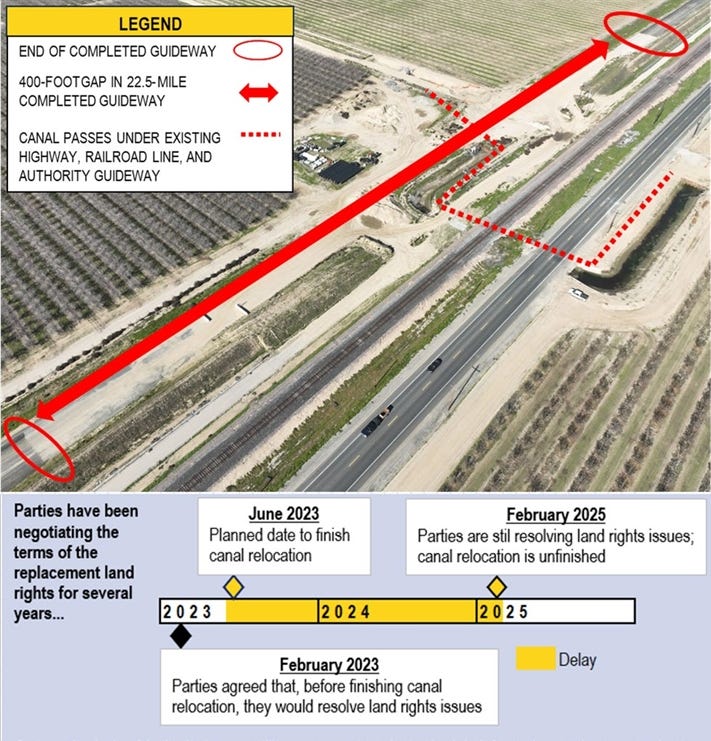The last few days have not been good ones for California’s high speed rail project.
In fact, very very few days in its entire existence have been good ones for the odious debacle.
Come to think of it, there has probably only been one, ever – the day it was approved by voters and while that was good for the project it was terrible for the state.
Thursday, Secretary of Transportation Sean Duffy announced a federal audit of the project and its finances. And Friday, the project’s own inspector general (IG) released a report that can only be called, um, less than complimentary.
The IG’s report noted that there have been massive problems with land acquisition and figuring out what to do with existing utilities and water canals and such. In fact, it turns out the project has been designing and building things that – once those issues are finally settled – will almost certainly have to be ripped up and replaced.
The report also noted other gaps in the system, such as this 400 foot space that has no approved plan to be fixed despite years of “work”:
One supposes the passengers could get out and walk around it, but that would defeat the purpose of it being “high speed” rail.
Note also that the high speed track is just yards from the existing freight/Amtrak rail line, lending an even greater level of superfluity to the entire project.
And just to make sure everyone knew this was a California project, the IG recommended hiring more lawyers and having the legislature pass a law forcing land and utility owners to come to terms more quickly.
As to the feds, a $4 billion dollar payout to the system planned under the Biden administration was supposed to take place soon – Duffy said that will not happen until they can figure out where the money has actually been going (the feds already have a billion or so sunk into the project.)
But these are just the latest hitches in the project’s gitalong. To understand the enormity of the failure – and why the feds, like relatives who keep lending money to their deadbeat cousins, are completely justified in wondering where the money has gone - one most go back to the beginning.
In 2008 – yup, 17 years ago – state voters approved a project with an expected cost of about $33 billion that would run from San Diego to Sacramento, mostly via the main trunk line between Los Angeles and San Francsico. And it was supposed to be entirely finished in 2020 – yup, five years ago.
Now, it is projected to cost about $130 billion for the LA to SF part alone and be actually fully completely done by, well, that’s not even projected anymore because – except for a couple of maps – the sections to Sacramento and San Diego are not being mentioned any more. The high speed rail Authority, the agency created to oversee the project, now claims it was only ever really supposed to be from LA to SF – that is false and an intentional lie, somewhat similar to the Authority releasing double the time and double the money figures days after the 2008 vote.
If only they were right.
At this point, the best-case scenario is not just pie in the sky it doesn’t even really exist. But extrapolating current Authority estimates and using comparative actual construction costs, completing the entire system will cost about $250 billion, or more than 700% over-budget.
As for timing, it will be about seven years before the first phase is done – that’s the one that has/will cost at least $35 billion and be built from Bakersfield to Merced, literally paralleling existing Amtrak service, which carries about 850,000 people a year in its seven round-trips a day (some go to Sacramento, some to Oakland from Bakersfield.)
High speed rail claims it will carry about 12 million people from Bakersfield through the Central Valley into (eventually) Silicon Valley.
At triple the ticket cost and saving maybe two hours on the trip.
To break things down further, the first bit which is being built now (see above) will cost about $35 billion, has the lowest potential ridership in the system, and is being built on the flattest bit of the entire project (trains – especially high speed ones – need as many flat bits as possible.)
For context, here’s a map of the project:
It’s that middle (red) part alone that has hoovered up the entire expected budget and will still not be done until at least ten years after the whole thing was supposed to be finished.
If you want even more details on the project, just search “high speed rail” on this Substack, but here’s one fun fact to emphasize the absurdity:
For comparison, NASA’s Artemis program – which in phase one involves four round-trips to the moon over the next four years– costs about $93 billion. Delving back into the math, Artemis ships will travel about 1.9 million miles for a cost of about $48,690 per mile or about 77 cents an inch.
Using the questionable HSRA number of $100 billion for its phase one, the project is costing about $192 million a mile or about $3,035 dollars an inch, or about 4,000-times as much.
To reiterate: 4,000 times the distance traveled cost to go to the moon.
So, what is the big picture?
First, the project will never be completed so notionally not only is it massively over budget it is technically infinitely over timeline.
Second, the project has not only failed to hit its budgetary and timeline projections, it has failed to generate even close to the number of real jobs promised….though it has done very by its politically-connected consultants.
Third, if it continues it becomes even more difficult to build. Sneaking into downtown San Francisco, let alone going up and down and through the mountains and valleys to get to San Diego on the proposed “inland route,” (btw, it’s why the current railroad hugs the coast – it’s just to damn expensive to build inland on that route) will cost tens of billions and take decades.
Fourth, speaking of tunnels, one must get from Bakersfield to LA and that is now planned to be accomplished by spending $736 million dollars a mile to tunnel its way through the mountains and earthquake faults and down to Burbank and then to LA.
Fifth, the ridership projections in theory mean that once everything is built a full-loaded 1,000 passenger train will have to leave SF headed to LA and vice-versa every 11 minutes for 18 hours a day to hit its projections. No train anywhere does that.
Sixth, speaking of income – the authority claims the train will make money. No high-frequency passenger train outside of Singapore, Japan, a few other Asian countries (and, amazingly the London subway system) makes money when factoring in capital costs. This will not be different.
Seventh, while the project was supposed to involve private investment not a single firm has stepped up to even seriously consider dropping a dime on the system. Interestingly, private money doesn’t even make sense as investors would want an 8% return while the state could actually just borrow money at 4%.
Eighth, the system is now designing stations and tracks on land it does yet own, designs that will almost assuredly change dramatically (and cost far more) when finalized. Imagine building a home and digging a basement and then realizing it needs to built on a slab foundation – fill it in and start over.
And ninth, since the state’s power grid cannot generate the electricity needed to run the system, the Authority is planning to build its own completely renewable system on land it owns. Imagine building a solar farm that is 500 miles long and 100 feet wide.
Without the $4 billion the feds were supposed to fund, even the first phase will not be completed, leaving viaducts and rights-of-way and guideways that have already been built to stand like Henge monuments to government failure.
Of course, that might in and of itself be interesting and allow for a complete repurposing of the system as is done back east with disused railways.
It may just turn out to be a low speed trail.




